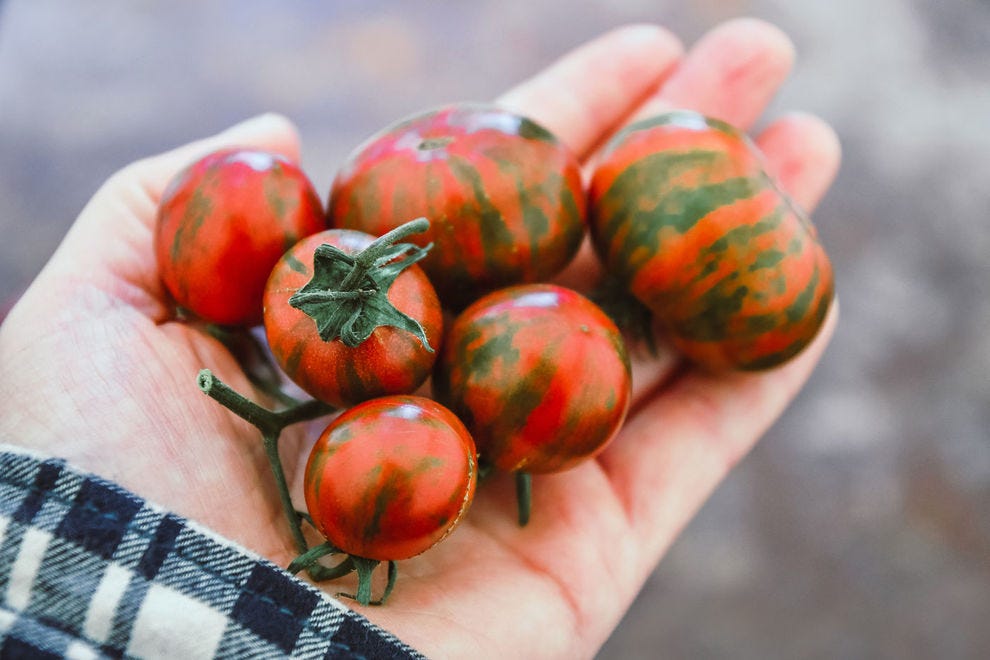What exactly makes an heirloom tomato, well, heirloom? Is it the tiger-like stripes? The vivid array of stoplight colors? How about the various lumps, bumps and bulges? Or is it something about the taste, maybe? I’m not about to let another tomato season go by without finally learning the answer, so let’s investigate.
Ancestry
 Heirloom varieties can be the ancestors of plants from over 100 years ago — Photo courtesy of Getty Images / Wildroze
Heirloom varieties can be the ancestors of plants from over 100 years ago — Photo courtesy of Getty Images / Wildroze
Heirloom tomatoes – called heritage tomatoes in the U.K. – are open-pollinated, non-hybrid cultivars of the nightshade genus. Cultivars are varieties or strains of plants that may be selected and pruned from generation to generation for their desirable traits, but are not in any way purposefully crossbred or grafted with other tomato varieties.
In this sense, heirloom tomatoes are purer strains of the fruit, less fussed with by the global agricultural revolution that diluted so much of the world’s biodiversity.
To truly be considered an heirloom tomato, the original plant that gave birth to generations of seeds must be traceable back to at least 1951, though many of the heirloom varieties we enjoy today are more than 100 years old. Heirloom cultivars typically carry both a common name, like Snow White Cherries, along with a scientific cultivar name.
In the absence of a time machine, the only way to carry on an heirloom cultivar from year to year is by collecting seeds by hand at the end of a harvest to be planted once more in the coming spring. That’s because while agricultural scientists have largely succeeded in transforming some varieties of tomato into annuals, or even plants capable of bearing fruit year-round, heirlooms are perennial by nature. They wither and die off with the first frost of the year.
Appearance
Heirloom tomatoes come in an array of colors, shapes and sizes — Photo courtesy of Getty Images / tvirbickis
Because heirlooms are pollinated only by insects, the wind and weather, and nature itself, these cultivars have not been purposefully bred into genetic submission in the way that iconic grocery store tomatoes have been. Heirlooms are therefore far less resistant to disease, lacking the hearty, waxy outer layer of skin that the agricultural industry has imparted upon mass-produced varieties of tomato.
As such, heirlooms have thinner skin that are less resistant to disease and fluctuations in weather. Many cultivars of heirlooms are especially prone to cracking, and many have what appear to be visibly bulging ribs.
But the colors! Man oh man, the colors. Heirloom tomatoes are some of the world’s brightest, boldest and most chromatic produce. Fire engine reds make grocery store options look pallid in comparison, along with bright yellows, deep greens, rich purples and even chocolatey browns.
Taste
 Heirloom tomatoes may not look like iconic tomatoes but they taste great! — Photo courtesy of Getty Images / asab974
Heirloom tomatoes may not look like iconic tomatoes but they taste great! — Photo courtesy of Getty Images / asab974
Did you know that the very same genetic mutation that gives so many of the grocery store varieties their singular shade of red also strips these same tomatoes of much of their flavor? Heirlooms are, on a genetic level, more robust and flavorful than the romas, beefsteaks and even cherry tomatoes available to us in stores year-round.
Heirloom cultivars produce tomatoes with higher levels of carotenoids, the vividly colorful compounds that provide cancer protective benefits when consumed by humans. They also produce dramatically higher amounts of sugars, giving heirlooms a sweet taste much more in keeping with the tomato’s often overlooked membership in the fruit family.
Price
 Because they’re not farmed using conventional methods, not all of these tomatoes can go to market, which means they can be a bit more expensive — Photo courtesy of Getty Images / krblokhin
Because they’re not farmed using conventional methods, not all of these tomatoes can go to market, which means they can be a bit more expensive — Photo courtesy of Getty Images / krblokhin
Produce grown by painstakingly collecting seeds each year by hand, to begin the process anew again the following spring, passing down the know-how from generation to generation for 100 years along the way isn’t going to come cheaply.
Heirlooms are indeed more expensive than their red, round cousins. The sad truth about heirloom farming is that not every one of these precious babies makes it to market, with plenty of fruit succumbing to disease or insects along the way.
Those that survive until summer fetch a well-deserved price tag. But if you ask a tomato lover, every extra cent is worth it.
Storage
 It’s best to eat heirloom tomatoes as quickly as you can — Photo courtesy of Getty Images / GomezDavid
It’s best to eat heirloom tomatoes as quickly as you can — Photo courtesy of Getty Images / GomezDavid
These beauties lack the hardiness that you’ve grown to take for granted when it comes to tomatoes. That means that the perfectly ripe heirlooms you select from the produce section or farmers market are already breaking down inside by the time you get them home.
Heirlooms should be eaten as close to the moment they are plucked from the vine as possible. And whatever you do, don’t try to buy yourself more time by putting heirlooms in the refrigerator. The cold will only accelerate their breakdown.
